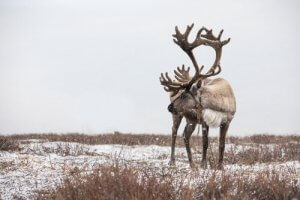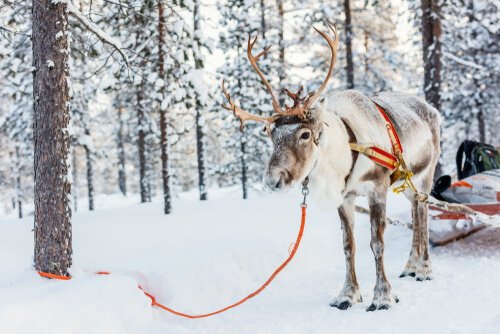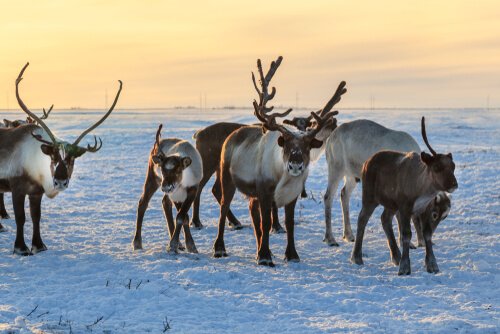7 Interesting Facts About Reindeer

The reindeer is an animal that is commonly featured in Christmas music and pictures. According to legend, reindeer pull Santa Claus’ sleigh, have red noses, have odd names and can fly. Of course, that’s the stuff of children’s stories. But how much do you really know about this deer that comes from the north? Learn some interesting facts about reindeer in this article.
These are animals that are made to live in the cold. Their noses warm the air they breathe before it gets to their lungs. Also, their whole body, even their hooves, has a thick covering of skin and fur.
In the wintertime, this species has to dig through the snow to find food. They dig using their antlers as well as their hooves and eat a certain type of lichen to get energy, better known as reindeer lichen.
Here are 6 interesting facts about reindeer
1. Both sexes have antlers
Reindeer are the only species of deer where both the males and females have a pair of antlers. They get a new pair each year. The male’s antlers can measure up to 51 inches long, and weigh up to 30 pounds! Female reindeer can grow antlers each year up to 20 inches long.
The size of the reindeer can vary considerably, depending on the sub-species. For example, forest reindeer in Finland can be about 8 feet long, from nose to tail. These animals have much larger feet and wider hooves, and their antlers grow larger and with more points.
2. A reindeer by any other name is still a reindeer
Depending on their country of origin, reindeer have different names. They are called reindeer in Europe, but in North America, reindeer refers to the populations in Eurasia, while caribou refers to the wild animal populations in North America.
In other regions, reindeer frequently refers to domesticated animals, while the caribou refers to wild animals. Reindeer belong to the Cervidae family, which includes deer, moose, and elk, among others. All of the members of the Cervidae family have antlers, hooves and large feet.
3. They are ideal for the cold weather
This species is definitely perfect for enduring long winters and low temperatures. You can find reindeer in Alaska, Canada, Greenland, Northern Europe, and in the north of Asia. They live in tundras, on mountains and in inhospitable forests.

The reindeer is uniquely equipped to live in extreme weather. As we said before, its nose functions as a small heater, and heats the air it breathes before the air reaches the lungs. It also condenses the water in the air it breathes in to keep the mucus membranes moist.
Its fur functions as a type of skin coat that doesn’t just trap air to insulate its body from the cold. The fur also works as a kind of flotation device when the animal enters the water. Reindeer are strong and quick swimmers. When they migrate, they have to travel through difficult terrain, and need to swim through wide rivers, and even through the freezing waters of the Arctic Ocean.
Their pads adapt depending on the season. In wintertime, the pads on the bottom of their feet contract and withdraw; their hooves become something like an ice pick that they use to cut and dig into the ice and snow to find food. In the summer, when the ground is softer and moist, the pads on their feet expand again, which gives the reindeer better traction.
4. Facts about reindeer: they don’t like living alone
Reindeer are very social creatures. They eat, travel and rest together in groups called herds. These groups can include from 10 animals up to a few hundred. In springtime, the herds can grow even more: from 50,000 to 500,000 members.
5. Baby reindeer skip childhood
Male reindeer are called bulls, females are called cows and babies are called calves, the same as with cows. Newborns can stand up after their first hour of life and can start to run a little while afterwards. They start their first set of antlers around their second birthday, and reach maturity between 4 and 6 years old. The life span of a reindeer is typically around 15 to 18 years.

6. Interesting facts about reindeer: they are strict vegetarians
Reindeer are herbivores, which means that they only eat plants. Their diet includes ferns, shoots, grass, moss, fungus and leaves. An adult reindeer can eat between 8 and 18 pounds of vegetation a day. Reindeer have an acute sense of smell, which is very useful when the ground is covered in snow and they need to find food.
They can smell lichen that’s full of energy and useful to help warm their blood, which is called reindeer lichen. This is even when the lichen is under up to 2 feet of snow.
7. Reindeer can run like the wind
Reindeer generally cover between 12 and 40 miles a day during migration, and can run at speeds of up to 50 miles an hour. Even babies only a day old could beat an Olympic runner. Not all reindeer migrate, but some travel longer distances than any other migratory mammal.
For instance, some populations of American reindeer migrate over 3000 miles per year. Reindeer are strong swimmers and can reach up to 4 to 6 miles an hour in the water. Migrating herds swim through huge lakes and wide rivers.
Now that you know all of the above facts about reindeer, don’t you agree that they are very impressive creatures? However, these magnificent animals are threatened by global warming, the exploiting of petroleum and other man-made causes. They will certainly need ongoing help and support from future generations to survive.
This text is provided for informational purposes only and does not replace consultation with a professional. If in doubt, consult your specialist.